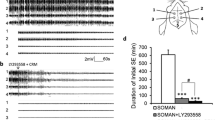Abstract
Control of seizure activity is critical to survival and neuroprotection following nerve agent exposure. Extensive research has shown that three classes of drugs, muscarinic antagonists, benzodiazepines, and N-methyl-d-aspartate antagonists, are capable of moderating these seizures. This study began to map the neural areas in rat brain that respond to these three drug classes resulting in anticonvulsant effects. Drugs of each class (scopolamine, midazolam, MK-801) were evaluated for their ability to prevent sarin-induced seizures when injected into specific brain areas (lateral ventricle, anterior piriform cortex, basolateral amygdala, area tempestas). Animals were pretreated by microinjection with saline or a dose of drug from one of the three classes 30 min prior to receiving 150 μg/kg sarin, subcutaneously, followed by 2.0 mg/kg atropine methylnitrate, intramuscularly. Animals were then returned to their cages, where electroencephalographic activity was monitored for seizures. Anticonvulsant effective doses (ED50) were determined using an up–down dosing procedure over successive animals. Scopolamine provided anticonvulsant effects in each area tested, while midazolam was effective in each area except the lateral ventricle. MK-801 was only effective at preventing seizures when injected into the basolateral amygdala or area tempestas. The results show a unique neuroanatomical and pharmacological specificity for control of nerve agent-induced seizures.
Similar content being viewed by others
References
Bertram, E., Zhang, D.-X., Mangan, P., Fountain, N., & Rempe, D. (1998). Functional anatomy of limbic epilepsy: a proposal for central synchronization of a diffusely hyperexcitable network. Epilepsy Research, 32, 194–205.
Braitman, D., & Sparenborg, S. (1989). MK-801 protects against seizures induced by the cholinesterase inhibitor soman. Brain Research Bulletin, 23(1–2), 145–148.
Dixon, W., & Massey, F. (1981). Introduction to statistical analysis (pp. 426–444). New York: McGraw-Hill.
Ebert, U., Wlaz, P., & Loscher, W. (2000). High susceptibility of the anterior and posterior piriform cortex to induction of convulsions by bicuculline. European Journal of Neuroscience, 12, 4195–4205.
Gale, K. (1995). Chemoconvulsant seizures: advantages of focally-evoked seizure models. Italian Journal of Neuroscience, 16, 17–25.
Lallement, G., Pernot-Marino, I., Foquin-Tarricone, A., Baubichon, D., Piras, A., Blanchet, G., et al. (1994). Coadministration of atropine, NBQX and TCP against soman-induced seizures. NeuroReport, 5, 1113–1117.
Loscher, W., & Ebert, U. (1996). The role of the piriform cortex in kindling. Progress in Neurobiology, 50, 427–481.
McDonough, J. H., & Shih, T.-M. (1993). Pharmacological modulation of soman-induced seizures. Neuroscience and Biobehavioral Reviews, 17, 203–215.
McDonough, J. H., & Shih, T.-M. (1997). Neuropharmacological mechanisms of nerve agent-induced seizure and neuropathology. Neuroscience and Biobehavioral Reviews, 21(5), 559–579.
McDonough, J. H., McLeod, C., & Nipwoda, M. T. (1987). Direct microinjection of soman or VX into the amygdala produces repetitive limbic convulsions and neuropathology. Brain Research, 435, 123–137.
McDonough, J. H., Dochterman, L. W., Smith, C., & Shih, T.-M. (1995). Protection against nerve agent-induced neuropathology, but not cardiac pathology, is associated with anticonvulsant action of drug treatment. Neurotoxicology, 15(1), 123–132.
Myhrer, T., & Andersen, J. (2001). Interference with visual memory in rats following infusion of the functional NMDA receptor antagonist, HA-966, into temporal regions. European Journal of Pharmacology, 428, 323–330.
Myhrer, T., Nguyen, N., Enger, S., & Aas, P. (2006). Anticonvulsant effects of GABA(A) modulators microinfused into area tempestas or substantia nigra in rats exposed to soman. Archives of Toxicology, 80(8), 502–507.
Myhrer, T., Enger, S., & Aas, P. (2008). Anticonvulsant efficacy of drugs with cholinergic and/or glutamatergic antagonism microinfused into the area tempestas of rats exposed to soman. Neurochemical Research, 33(2), 348–354.
Paxinos, G., & Watson, C. (2005). The rat brain in stereotaxic coordinates (5th ed.). Burlington: Elsevier.
Piredda, S., & Gale, K. (1985). A crucial epileptogenic site in the deep prepiriform cortex. Nature, 317, 623–625.
Racine, R., Burnham, W., & Gartner, J. (1973). First trial motor seizures triggered by amygdaloid stimulation in the rat. Electroencephalography and Clinical Neurophysiology, 35, 487–494.
Shih, T.-M., Koviak, T., & Capacio, B. (1991). Anticonvulsants for poisoning by the organophosphorus compound soman: pharmacological mechanisms. Neuroscience and Biobehavioral Reviews, 15, 349–362.
Shih, T.-M., Duniho, S., & McDonough, J. H. (2003). Control of nerve agent-induced seizures is critical for neuroprotection and survival. Toxicology and Applied Pharmacology, 188, 69–80.
Shih, T.-M., Kan, R. K., & McDonough, J. H. (2005). In vivo cholinesterase inhibitory specificity of organophosphorus nerve agents. Chemico-Biological Interactions, 157–158, 293–303.
Shih, T.-M., Rowland, T., & McDonough, J. (2007). Anticonvulsants for nerve agent-induced seizures: The influence of the therapeutic dose of atropine. Journal of Pharmacology and Experimental Therapeutics, 320, 154–161.
Acknowledgements
The authors wish to recognize the excellent technical assistance of Kerry Van Shura and Jessica Chandler and statistical assistance of Robyn Lee. This research was supported by the Army Inter-Laboratory Independent Research.
Author information
Authors and Affiliations
Corresponding author
Additional information
Proceedings of the XIII International Symposium on Cholinergic Mechanisms
The opinions or assertions contained herein are the private views of the authors and are not to be construed as official or as reflecting the views of the Department of the Army or the Department of Defense. In conducting the research described in this report, the investigators adhered to the Guide for the Care and Use of Laboratory Animals by the Institute of Laboratory Animal Resources, National Research Council, in accordance with the requirements for an Association for Assessment and Accreditation of Laboratory Animal Care International (AAALAC) accredited facility.
Rights and permissions
About this article
Cite this article
Skovira, J.W., McDonough, J.H. & Shih, TM. Protection Against Sarin-Induced Seizures in Rats by Direct Brain Microinjection of Scopolamine, Midazolam or MK-801. J Mol Neurosci 40, 56–62 (2010). https://doi.org/10.1007/s12031-009-9253-0
Received:
Accepted:
Published:
Issue Date:
DOI: https://doi.org/10.1007/s12031-009-9253-0




